
The last IJN light cruisers
The Agano class (阿賀野型軽巡洋艦) were the last Japanese light cruiser built in Japan, before the larger Oyodo class, mostly cancelled. But they arrived late in the war: The fourth, IJN Sakawa, was only completed in December 1944, very last Japanese cruiser since shipyards were busy turning destroyers instead and soon, ASW escorts. This Class included Agano (launched 1941, compl. 1942), Noshiro and Yahagi, (launched 1942, comp. 1943) and Sakawa, much delayed. Classified as light cruisers, they were part of an extensive program to replace older cruisers such as the 22 years old Kuma, Nagara and Sendai classes. This was a considerable number of cruisers, 17 in all.
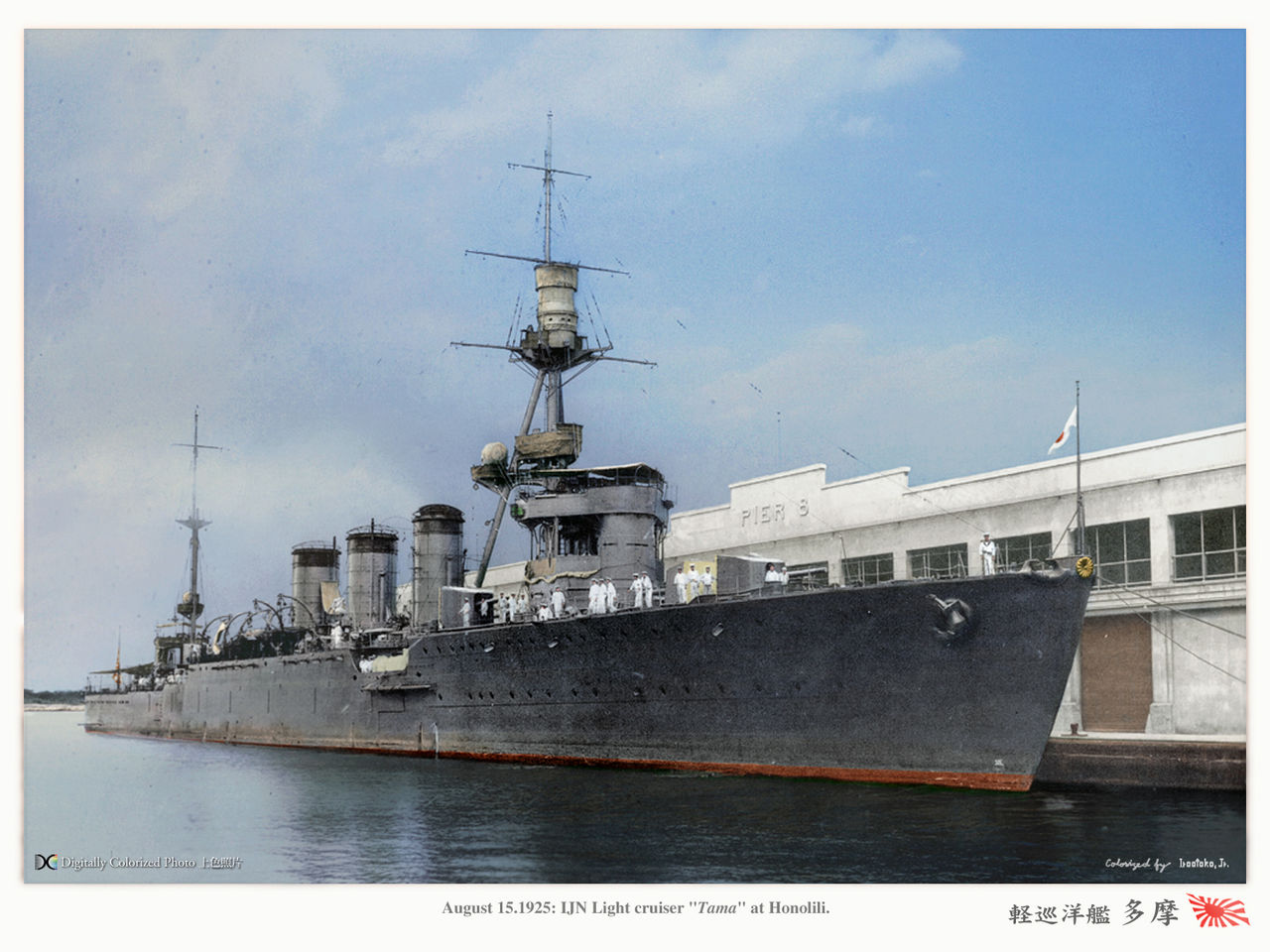
IJN Kuma, which was scheduled to be replaced by IJN Agano as per the Fourth 1936 Fleet Supplemental Budget.
They were also doubling as destroyers leaders and therefore fast at 35 knots, with still reconnaissance capability with their two seaplanes, and yet still an armament able to clash with any USN destroyer. In addition to a large AA battery (61 on Sakawa by 1945) thay had torpedo tubes with the deadly “long lance” type. Three were sunk in action: Agano in February 1944, Noshiro in October 1943, Yahagi in April 1945. Sakawa survived, but seized by the USN to be part of the Bikini Atoll atomic test “Able” on July 2, 1946.
Design of the Agano class
Design development of this class was an interesting story: The Imperial Japanese Navy wanted in 1919 a standardized design of light cruisers which can be used in large numbers as flagships for destroyer, but also submarine squadrons in the prewar strategy. The initial requirements called for a 5,500 ton displacement and this led to the Kuma, Nagara and eventually the Sendai class in 1923, cancelled because of the Washington treaty. These scouts and leaders became famous with their three and four funnels and inline single mount artillery. They were used in WW2 to the bone, often for secondary roles, however, by the 1930s they were already regarded as obsolete: The new “special type” destroyers were faster, and even better armed, even having a greater endurance.
As soon as the London Naval Treaty restructions were out of the way as Japan tored all treaties in 1936, the Navy General Staff developed for the Fourth Fleet Supplemental Budget an ambitious on a per-one basis, thirteen new 6,000 ton cruisers to replace these old vessels. They were to be built between 1939 and 1945. As the former ones, they were intended as flagships, leading six of the “special type” destroyer squadrons, or, like their forebears, seven long range submarines. The new design was ready already in October 1937 but construction was delayed due to Japanese shipyards full to the brim, notably by reconstructions of existing cruisers. Construction costs at the time was estimated 16.4 million yen per vessel, which was cheap in comparison to anything else. A Mogami class costed, late 1930s reconstruction included, almost thrice as more.
Hull construction & general characteristics
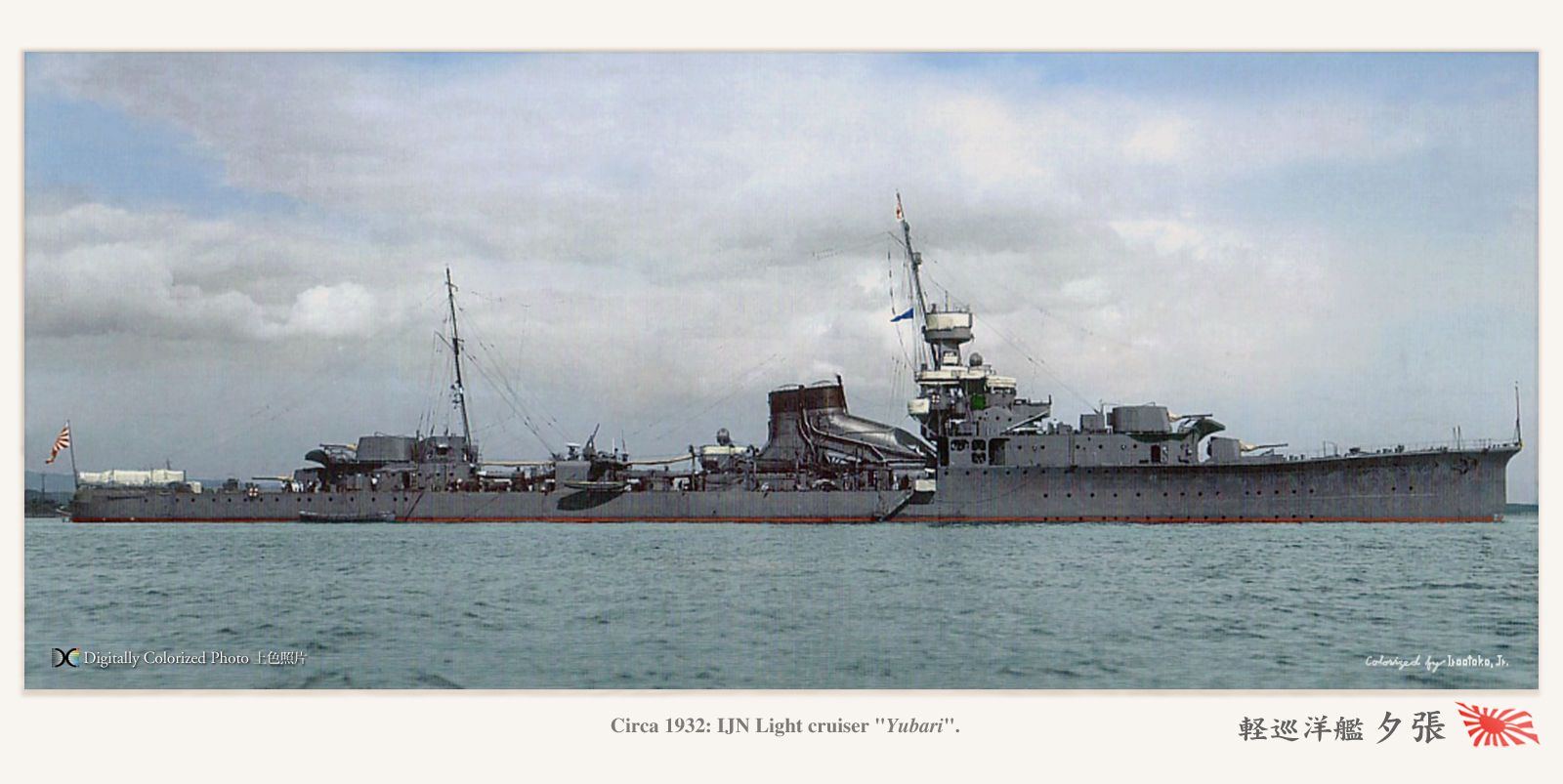
IJN Yūbari was a source of inspiration, although many of its shortcomings had been nailed and fixes long ago.
To gain time and not starting from a completely blank page, engineers started from technologies developed for the light cruiser Yūbari. Many modifications were done of course, notably to sufficiently bracing the hull, a better armament and more modern powerplant, with a large place left for AA. The final design resulting in a graceful, uncluttered deck line. She also had a tall and narrow bridge and single funnel funnel.
Thanks to past experiences in the wake of Yuzuru Hiraga designs, the Agano class managed to kepp her weight down. This resulted in good stability and seaworthiness, but more importantly, additions of AA in WW2 without comprising these. Their hulls was 174.1 meters (571 ft 2 in) long, overall. The beam was 15.2 meters (49 ft 10 in), making for a 11:1 ratio, very favourable to high speeds. The draft was moderate at 5.63 meters (18 ft 6 in), so in theory they could have also roamed the YangTse far north without issues.
Final displacement was established to 6,652 metric tons (6,547 long tons) standard and up to 8,534 metric tons (8,399 long tons) when fully loaded and combat ready. The crew comprised 51 officers and 649 ratings, but as flagship they carried 6 more officers and 20 assistants. This was almost 2,000 tonnes larger than a Kuma class.
Propulsion
The Agano class was powered by four geared steam turbines driving a single propeller shaft, the while fed by six Kampon Ro Gō water-tube boilers. These relatively small turbines were designed to produce 25,000 hp each, so a total of 100,000 shaft horsepower (75,000 kW) in all for 35 knots (65 km/h; 40 mph). Fuel oil onboard was generous for their side, and enough to carry them on a one-way trip of 6,300 nautical miles (11,700 km; 7,200 mi) at 18 knots (33 km/h; 21 mph) cruise speed. Of course, this fell from 30+ kts. But that was already superior to many IJN destroyers, and overall, superior to the Kuma class which were capable of 9,000 nmi (17,000 km) but at 10 kn. This was down to 5,000 or less at 18 kts.
Armor Protection
Of course being a light cruiser, this was assuredly the weak part of the design. The hull reused the structural armour solution already used on the Yubari to save weight, and notably better than the Kuma class, with more armour concentrated on the most important parts of the ship:
-Propulsion machinery: waterline armor belt 60 mm (2.4 in) thick
-Transverse bulkheads fore and aft (machinery spaces): 20 mm (0.8 in)
-Middle deck 20 mm (0.8 in.
-Main ammo magazines: 55 mm (2.2 in) thick box sides
-Main ammo magazines, roof: 20-millimeter
-Main ammo magazines, transverse bulkheads: 20-25 mm.
-Steering gear armoured box: 16–30 mm (0.6–1.2 in)
-Gun turrets 19 mm (0.7 in).
These figures looks rather weak, but this was intended to deal with destroyers rounds and no more.
Note there is no conning tower. At that stage, the IJN arrived at the same conclusion to everyone else, that the CT was never used in actual combat because the staff always privileged better visibility, and it was eliminated from the design right away.
Armament
It was “light” for the IJN standards of the time, especially the much larger Mogami class, but in par with the initial requirements of replacing the antiquated seven 14 cm/50 3rd Year Type naval guns. This was done with twin turrets and modern 6-in guns with far greater performances. The rest of the armament was very diverse, and expanded considerably during the war, from just six to ten times more 25 mm AA (see later). There were differences bnetween them at completion, notably Yahagi that arrived much later. IJN Yahagi for ecample was completed with four twin 25mm/60 Type 96-AA in addition and Sakawa had ten triple 25mm/60 from the start plus eighteen 25mm/60 Type 96, two quad 610mm TT and two 2 DCR for 36 depht charges.
3×2 152 mm/50 Type 41 guns
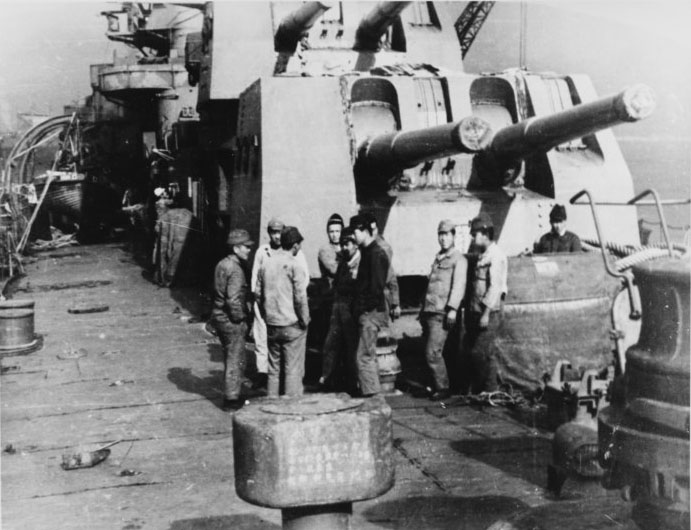
Two of these turrets of a new type and style were located in a pair forward and one aft at deck level. This was seen as rather “weak” for their size, but still a good equivalent of what the Kuma class had. The IJN however soon started to look for a longer vessel with one more turret aft, planned in 1942 but never materialized (see later).
The Type 41 was derived from the old Vickers “Mark M” provided for the casemates of the Kongō-class. As the Kongō-class were modernized with new 12.7 cm/40 DP guns, the casemate guns ended in storage, until reused on the Agano-class and the remainder in Guam and other coastal defense batteries.
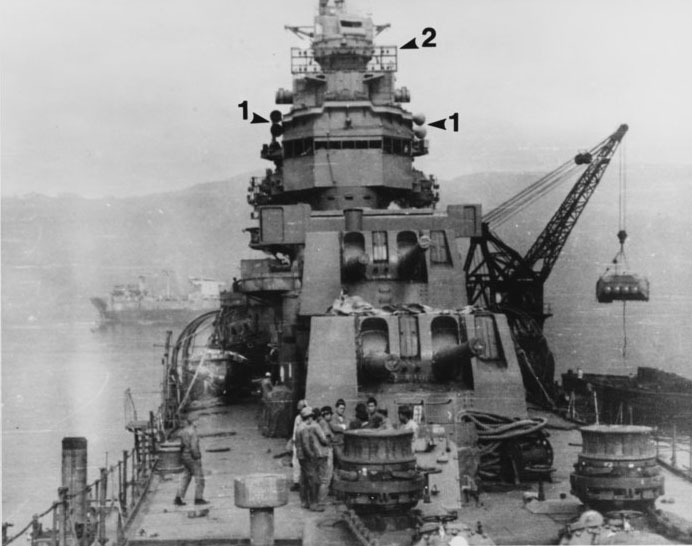
The Agano had them mounted in a new cradle enabling 55°, for anti-aircraft fire with with 6 rounds a minute anti-aircraft use was compromised.
The shells were 100 pounds (45 kg) AP types, 152.4 mm exact caliber, depressing to -5 and traversing to -150/+150. The guns fired at 850 metres per second (2,800 ft/s) with an effective range up to 21,000 metres (23,000 yd) at 45°.
2×2 76.2 mm Type 98 DP guns
Another originality of this design was to use twin mounts for “dual purpose”, but their capabilities against other ships was not impressive. Rather they were seen as anti-MTB weapon, although limited in range. The 8 cm/60 Type 98 naval gun designed in 1938 were only installed on the Agano class and IJN Ibuki, uncompleted fleet carrier based on the Agano class. They were both located on a raised platform at the foot of the bridge, behind the lower telemeter.
Stats were as follows:
Total Mass 1,320 kilograms (2,910 lb), 4.777 meters (15 ft 8.1 in) barrel and mount, 4.566 meters bore.
The gun used a Horizontal sliding block breech.
Shell: 5.99 kilograms (13.2 lb), 76.2 millimetres (3.00 in)
Elevation/traverse -10 to +90° and -150 to +150°
Rate of fire: 25 (max, theoretical), 12 effective
Muzzle velocity: 900–920 M/sec. (3,000–3,000 ft/s)
Effective range: 13,600 meters (14,900 yd) – Ceiling unknown.
2×3 25 mm AA guns
The standard AA gun of the IJN, derived from a Hotchkiss model.
In short: +85° and 360° manual traverse/elevation, ROF 200–260 rpm (cyclic) at 820 m/s (2,700 ft/s), max range 6.8 km (4.2 mi) and effective 3 km (9,800 ft) fed by 15-round box magazines.
More
2×2 13.2 mm (0.52 in) Type 93 AA HMG
Still considered in 1940, but obsolete and replaced by 25 mm guns when possible during WW2.
In short: -15/+85° and 360° elevation/traverse, manual, ROF 450 rounds/min, range 1,000 meters (3,300 ft) at 45°, fed by 30 rounds box mags.
More
2×4 610 mm torpedo tubes
They were fitted in two enclosed banks and inline as common to most IJN destroyers: One was located aft below the catapult and the other below the aircraft platform forward of it, with the problem of the pillar interfering to its arc of fire. But it least they were well protected. Torpedo explosion of the sensitive “long lance” had been quite a topic in WW2.
In short, the Type 93 “Long Lance” probably the best WW2 torpedo, a “secret weapons” which did ravages, especially in the narrows of Guadalcanal. It weighted 5,952 lbs. (2,700 kg) for 1,080 lbs. (490 kg) Type 97 wahread, powered by Kerosene-oxygen wet-heater and capable of a max range of 43,700 yards (40,000 m) at 36-38 knots or shorted up to 50 kts. More.
Type 95/Type 2 depth charges
All Agano class vessels had two depth charge chutes for 18 depth charges. Some sources states 16, but it’s perhaps related to their types, either the 95-Shiki or Type 2 Shiki. It seems they had no depht charge launcher. However the carried two paravanes attacked on the superstrcture forward. Some sources states they carried three Type 88 mines, but plans shows no mine rails and it is not corroborated in most sources. More on IJN Depht Charges or this.
Sensors
They were completed with radars from the start, with upgrades from 1943, on Agano first, then Yahagi and Noshiro. Sakawa was given a comprehensive suite, with a single Type 1 2-go radar, two Type 2 2-go, and two type 3 1-go radars, but no upgrade later.
These were the:
-Type 1, 2-go Radar
-Type 2, 2-go Radar
-Type 3, 1-go Radar
Due to their ASW role, they were also equipped with sonars and hydrophones: IJN Agano had a Type 93 sonar, Noshiro and Yahagi the same and Sakawa was completed with a Type 3 sonar.
They all were equipped in common with a Type 93 Model 2 hydrophone installation (93 Shiki 2-Go).
Onboard aviation

Aichi E13A onboard IJN Yahagi at the time of Operation Ten-Go, April 1945.
It seems in some sources that Agano and Noshiro were planned to receive with 2 seaplanes of the Kawanishi E15K1 Shiun “NORM”* while the others had the smaller, more common Aichi E13A floatplane. Thats perhaps the reason why the first two had a longer catapult of 26 m (85 ft 4 in), while Yahagi and Sakawa had a 19-meter catapult instead. Both shared however the same platform mid-ship to manage aircraft, with an “X” pattern railings and three hubs to move around the floatplanes on their chariots, having one in maintenance and another ready on the catapult aft, served by the gooseneck boom-crane anchored at thee mainmast’s foot.
*The Kawanishi E15K1 Shiun “NORM”, was a 1939-spec based 2-seat high-speed reconnaissance floatplane, fast enough to evade interception and still having a 800-nautical mile range. It was planned to equip a new class of cruisers indeed used as flagship for submarines which themselves operated six of these. But mostly they were intended for IJN Ōyodo and its sister ships, also ordered in 1939, not the Agano class, and i can’t find any reference that it was used on any of these cruisers. The program was much delayed and despite making its maiden flight on 5 December 1941, six prototype were evaluated from 1941 to 1942, Production and service was reached only by April 30, 1944, but they were not satisfactory and further production cancelled in February 1944 (15 built total)
Modernizations of the Agano class
-In 1943, Agano received an additional 2×3 25mm/60 Type 96 in replacement for its Type 93 HMGs, and two twin or the same, plus a Type 1 2-go radar.
-In February 1944 IJN Yahagi received four twin 25mm/60 Type 96 plus four triple or the sae and eight single, for a total of 34 AA guns.
-One month later IJN Noshiro had her two twin 13.2mm/76 removed for the addition of six triple 25mm/60 Type 96 plus 18 single, for a total of 36.
-In July 1944, Noshiro received another extra two triple 25mm/60 Type 96, four single (now 44) plus a Type 96 and a Type 2, 2-go, and a type 3 1-go radars.
-At the same time, Yahagi received fourteen single (48), plus the Type 2 2-go, and type 3 1-go radars (note some sources states four extra triple, but this is more than the later additions for the recoignised total of 61).
-Eventually in November she had an extra ten single 25mm AA (58) as the sole survivor of her class and then presumably four more in 1945 to reach 61.


Author’s profile illustration Yahagi 1944
Specifications
Displacement 6,550 t. standard -8,530 t. Full Load
Dimensions 174 m long, 15,20 m wide, 5,63 m draft
Propulsion 4 shaft, Kampon turbines, 6 boilers, 100,000 hp.
Top speed 35 knots
Armor from 50 to 85 mm
Armament 6 x 152 (2 × 3), 4 x 100 (2 × 2), 32 x 25 AA, 16 DCT, 8 x 610 mm (2 × 4) TTs, 2 seaplanes
Crew 730
The model corner
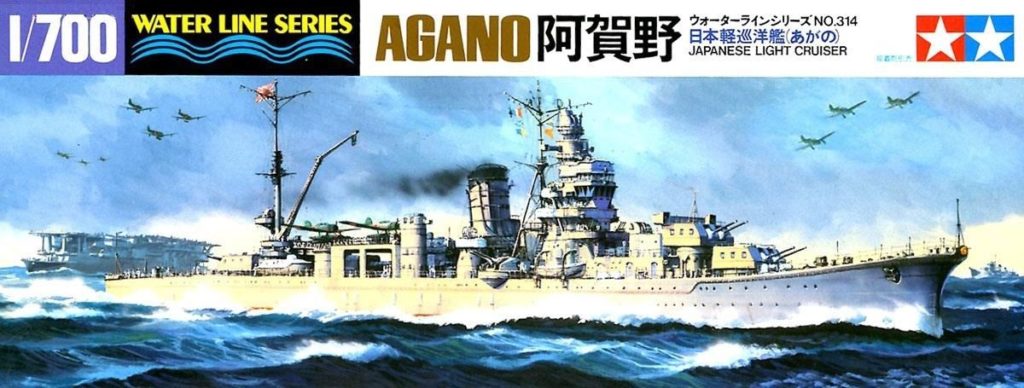
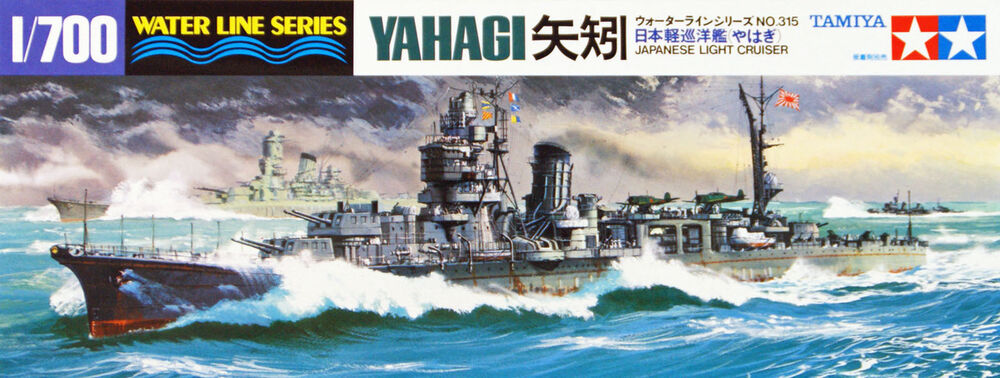
The Agano had been well covered by Japanese kit manufacturers as expected, so i would rather only cite the unusual scales here (that is not 1:700):
hhhhhhhhhhhhh
Sources
Links
http://www.combinedfleet.com/radar.htm
https://www.navypedia.org/ships/japan/jap_cr_agano.htm
http://www.combinedfleet.com/agano_t.htm
Nishida, Hiroshi (2002). “Agano-class light cruisers”. Imperial Japanese Navy. 8 December 2012, Retrieved 21 September 2014.
Parshall, Jon; Bob Hackett; Sander Kingsepp; Allyn Nevitt. “Imperial Japanese Navy Page” (Combinedfleet.com): Agano class
Books
Lacroix, Japanese Cruisers, p. 794.
Jentsura, Hansgeorg (1976). Warships of the Imperial Japanese Navy, 1869-1945. NIP
Stille, Imperial Japanese Navy Light Cruisers 1941-45 , pages 34-39;
Brown, David (1990). Warship Losses of World War Two. Naval Institute Press.
Dull, Paul S. (1978). A Battle History of the Imperial Japanese Navy, 1941-1945. Annapolis, Maryland: Naval Institute Press.
Jentschura, Hansgeorg; Jung, Dieter & Mickel, Peter (1977). Warships of the Imperial Japanese Navy, 1869–1945. NIP.
Lacroix, Eric & Wells II, Linton (1997). Japanese Cruisers of the Pacific War. NIP
Roscoe, Theodore (1949). United States Submarine Operations in World War II. NIP
Stille, Mark (2012). Imperial Japanese Navy Light Cruisers 1941-45. Osprey.
Whitley, M.J. (1995). Cruisers of World War Two: An International Encyclopedia. NIP
Videos
Gallery, 3D reconstitutions in WoW
The Agano class in action
The Agano class were built in three yards: Agano by Sasebo Naval Arsenal (LD 18 June 1940, LC 22 October 1941n Comp. 31 October 1942), Noshiro at Yokosuka Naval Arsenal (LD 4 September 1941, LC 19 July 1942, Comp. 30 June 1943) and the remainder in Sasebo Naval Arsenal: Yahagi (LD 11 November 1941, LC 25 October 1942, Commp. 29 December 1943) and Sakawa (LD 21 November 1942, LC 9 April 1944, Comp. 30 November 1944).
They were among the last IJN cruisers to enter Japanese service. The first in October 1942, and the last in November 1944. By that stage, the war completely changed in nature and prospects were bleak. They generally saw little service, around a year on average before being lost in action. These “midget cruiser” more destroyers leaders than fully fledged cruisers, had a hard time against the USN cruisers.
Losses shows that none was lost in classic naval combat. Agano was attacked bay air in Rabaul and later from TF38 on 11 November, and underway for for drydock repairs, ambushed north of Truk by USS Skate (SS-305) and sent to the bottom on 16 February 1944. The two others also went down by air attacks: Noshiro west of Panay while withdrawing from Samar, spotted by the air group of USS Wasp and USS Cowpens on 26 October, attacked and sunk. Yahagi teamed with Yamato for a suicide atack of Okinawa, and targeted by multiple air groups, taking seven torpedoes and a dozen bombs on 7 April 1945. Only Sakawa survived, never really engaged or damaged but by sporadic air attacks.
 IJN Agano
IJN Agano
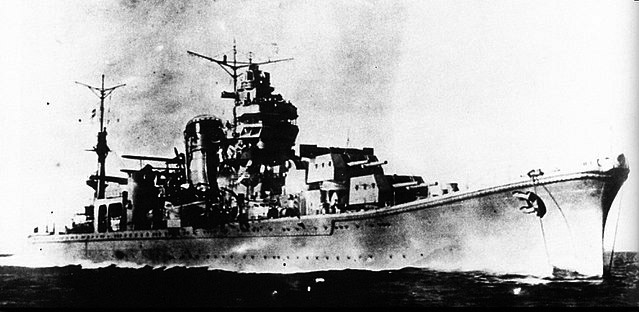
IJN Agano (after the Agano River) after her completion on 31 October 1942 became as intended flagship of Destroyer Squadron 10 (Sentai 10) Third Fleet, from 20 November after short training. She sailed from Kure to Truk, Carolines, on 1 December, with Rear Admiral Susumu Kimura making her his flagship. Her captain was Ko Nakagawa. On 16 December she the carrier IJN Jun’yō covering a troop convoy to Wewak-Madang (New Guinea). They also covered the landing at Hollandia before and went back to Truk (20 December).
Next, she covered the evacuation from Guadalcanal (Operation KE, 31 January-9 February 1943) a total of 11,700 Japanese soldiers. Sje was reassigned next to the 1st Mobile Fleet but returned to Kure by May to complete her sea trials and post-fixes. Back in the Combined Fleet, the Aleutian Islands operation was cancelled after Attu fell on the 29th and she returned to Kure for a refit (3 June-2 July). She departed for Truk on 9 July, as escort for the First Carrier Division, also carrying troops and supplies.
The cnvoy arrived unmolested in Truk on 15 July and Agano ferried troops and supplies to Rabaul (19–26 July) before being sent to Eniwetok in response to the allied attack on Tarawa (18 September). But the search led to nothing and they went back to Truk on the 23th. Partly fake American radio traffic suggested an assault on Wake and the fleet departed on 17 October for Eniwetok again, but for nothing. Agano was soon back to Truk, but soon, the skills of her crewws would be seriously tested:
Agano at the Battle of Empress Augusta Bay
Agano was at the time flagship of Rear Admiral Morikazu Osugi. She departed Truk on 30 October for Rabaul as infos came from US preparations for an attack on Bougainville, 1st November. A considerable force under Rear Admiral Sentarō Ōmori sailed by night, arriving on 2 November (two heavy cruisers, Myōkō and Haguro, two light cruisers, Agano and Sendai, six destroyers), but they had been spotted the previous day at 21:00 by US aviation and TF 39 (four light cruisers of CruDiv 12 – USS Montpelier, Cleveland, Columbia, and Denver, eight destroyers of DesDiv 45-46) was detached in interception.
Omori had his ships manoeuvering to take three staggered columns, and Agano was in the outer one, southernmost column trailing the main body and leading three destroyers, the two heavy cruisers in the middle. She had launched her two floatplanes this night, and one claimed to have spotted a US cruiser and three destroyers, about 20 nmi south of their position. At 01:20 Ōmori ordered a 180-degree turn to open the distance, waiting for the pilot’s confirmation and investigate Empress Augusta Bay. One hour later American transports were spotted, plus three minelayers and destroyer escort leaving the bay. After a new course change at 02:25, without radars to keep track of one another, the formation was broken.
US radars however picked them up from 36,000 yards (33,000 m), at 02:27. Rear Admiral Aaron Merrill in command of TF 39 ordered his destroyers forward, to make a torpedo attack while his cruisers would prepare to dodge Japanese ones while closing to open fire at short range. The idea was the torpedo hits would illuminate their targets, and would be the signal to open fire. 25 torpedoes were fired by 02:46 but the destroyer were spotted and reported, so the Japanese turned while Merrill believed he was spotted so ordered his cruisers to open fire, concentrating on IJN Sendai (northernmost outer column).
The cruisers and destroyers manoeuvered, both to avoid US torpedoes and fire theirs led to a collision and many near misses, US cruisers concentrated on the heavy cruisers center column at 03:05. Omori made a 270° turn away, across the path of Agano’s column and Myōkō rammed the destroyer IJN Hatsukaze while Haguro nearly avoided Wakatsuki. After he thought to have sunk three US cruisers, he ordered to cease fire and retired at 03:29. Osugi onbboard Agano ordered to fire eight torpedoes at 03:40 before disengaging, making no hit. Based on ships sunk or damaged, this was a US victory the last of the Somomons. Omori could not fell on the US transports as planned and took more damage than US forces.
Back to Rabaul, Agano was was air-attacked by USS Saratoga and USS Princeton on 5 November. A bomb near-miss damaged one AA mount. Reunited with IJN Noshiro they were scheduled to sail and return to Empress Augusta Bay, cancelled however on 7 November. Task Group 50.2 attacked Rabaul afterwards, Agano was this time hit by an Avenger’s Mark 13 torpedo. Her stern was badly damaged, as her propeller shafts. RADM Osugi was also injured in the attack. Emergency repairs allowed her to depart Rabaul escorted by Urakaze for Japan. They were spotted en route by USS Scamp, launching six torpedoes. One hit Agano amidships: She had all her boiler rooms flooded and power cut. USS Albacore, arrived in the meantime, approach for an attack but was repelled by Urakaze. IJN Noshiro and Nagara were ordered to assist her and take her in tow. This took more than 24h, and Agano was lucky to avoid more attacks in her state. She was towed by Nagara back to Truk on 16 November.
After patching her up with the repair ship Akashi until 15 February 1944 she left Truk again for main repairs home, escorted by IJN Oite and the submarine chaser CH-28. On the afternoon of 16 February while 160 nm (300 km) north of Truk she was spotted and torpedoed by USS Skate. From the spread of four torpedoes, she had two hits starboard, at 16:44. Boiler Room No.2 was flooded, she took a 12° list and her crews had to combat a large fire. But nothing could stop her sinking and Oite rescued 523 survivors at 20:00-23:30 when captain Nakagawa ordered to abandon ship. Agano disappeared under the waves at 01:50, 17 February, stricken on 31 March. However the surviving crew was not safe either. The following morning, IJN Oite was attacked by several TBF Avenger from TF 58 participating in Operation Hailstone, sinking with both crews.
 IJN Noshiro
IJN Noshiro
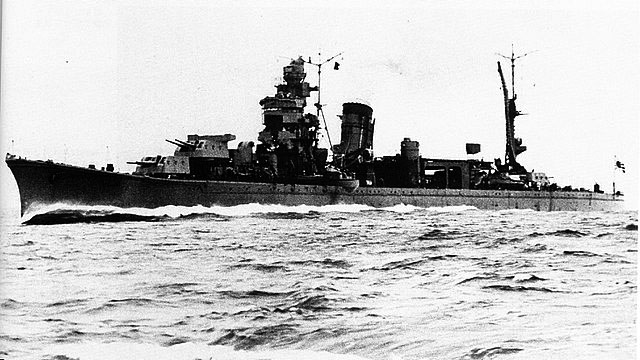
IJN Noshiro was completed by June 1943, assigned to the 1st Fleet for training, off of Hashirajima. On 15 August 1943, she was reassigned to the Kutita’s second Fleet as flagship, DesRon 2 in place of the sunken Jintsū at Kolombangara.
On 18 September 1943, air raids on Tarawa by USS Lexington, Princeton and Belleau Wood had the Combined Fleet scrambled to Eniwetok, but made no contact. From 17 October 1943 another attempt, this time to find TF 15 (Wake attack) failed. On 1 November the Bougainville Campaign saw a battle in which Agano was present, at the Battle of Empress Augusta Bay and Noshiro departed Truk with Sentai 4 (Atago, Takao and Maya) and Sentai 7 (Suzuya, Mogami), Sentai 8 (Chikuma), and four destroyers. They entered Rabaul on 5 November 1943, refueled in Simpson Harbor from Kokuyo Maru but attacked by USB aviation from TF 38, Noshiro bing hit by Mark 13 aerial torpedo, which was a dud which only left a bump.
On 12 November 1943 she departed to assist Agano torpedoed by USS Scamp, and towed by Sendai to Truk under her protection. On the 20th Operation Galvanic to retake the Gilbert Islands. Noshiro sailed from Truk with Suzuya, Kumano, Chōkai, Ōyodo and destroyers, being attacked en route on 1st January 1944 by the air groups of USS Bunker Hill and Monterey. She received damage, enough to have one gun turret disabled and and ten crewmen killed.
On 19 January 1944, she assisted the torpedoed IJN Un’yō by USS Haddock, towed back to Saipan. She was repaired and overhauled later in Yokosuka, completed by 28 March 1944.
Noshiro went to Davao and Lingga (5 April) with Sentai 4′ and Sentai 5 (Myōkō and Haguro) and were attacked en route by USS Dace, missing with all six bow torpedoes. She was spotted by USS Darter, too far to act. They were ambushed in Davao Bay on 7 April, but USS Scamp was too far, although on the 18, USS Gurnard fired and missed. IJN Noshiro at last took part in the Battle of the Philippine Sea on 19 June 1944, still flagship, RADM Mikio Hayakawa in the Vanguard Force. She made it out unscaved.
In June-July she was overhauled in Kure, and on the 8th departed with troops and material aboard to Singapore, remaining there for training in August and September. On 18 October she sailed to Brunei and prepared for an operation which became the Battle of Leyte Gulf on the 22th conducting DesRon 2 with the “A” or Center Force, Kutita’s First Mobile Striking Force. She was present at the battle of Sibuyan Sea on the 24th, attacked by 11 waves of USN aicraft from TF 38. Yamato, Nagato, Haruna, Myōkō and Tone were all damaged but Noshiro escaped.
She was at the Battle off Samar the following day, attacking the CVE USS White Plains with her main artillery, but was hit by an US destroyer. She also shelled USS Gambier Bay, which was sank.
On the 26th west of Panay, she was among the ships targeted by some 80 Grumman TBM-1C Avenger from USS Wasp and Cowpens and ha a hit in her AA shell magazine, but the fire was mastered. She also dodged torpedoes of the second wave, but luck turned in the third with a successful pincer: She received a Mark 13 at the level of No.3 boiler room, quickly flooded, and later in turn No.1 boiler room and the rest by pressure. Her speed fell to nil and she ended with a 16-degree list to port.

Emergency repairs took place, the destroyer IJN Hamanami coming alongside to carry to safety RADM Hayakawa, transferring his flag to Yamato. At 10:14 the fourth attack (28 Grumman TBMs, Curtiss SB2C-3) from USS Hornet cost Noshiro the loss of No.2 turret amthough her AA claimed several attackers. Captain Kajiwara ensire the forward magazines were flooded but it was hoepeless and 5 minutes afterwards he gave the order to abandon ship. She sank at 11:13 the the crew rescued by Akishimo and Hamanami, including Sueyoshi Kajiwara. There were and 328 rescapees, and she was stricken on 20 December 1944.
 IJN Yahagi
IJN Yahagi

Completed in Sasebo NyD, IJN Yahagi from 29 December 1943 became flagship of Destroyer Squadron 10, 3rd Fleet adn worked out initial training and sea trials under command of Captain Tameichi Hara. By February 1944 she sent to Singapore for completing her training while patrolling of the Lingga Islands. In May she was ordered to Tawi Tawi to escort the best fleet carriers IJN Taihō, Zuikaku and Shōkaku with the heavy cruisers Myōkō and Haguro (Admirak Jisaburo Ozawa First Carrier Striking Force) en route to attack the US 5 Fleet off Saipan. Yahagi as flagship of DesDiv 10 conducted Asagumo but ‘s Urakaze, Isokaze and Tanikaze from DesDiv 17 and Wakatsuki, Hatsuzuki, Akizuki and Shimotsuki from DesDiv 61 tasked to screen the formation. He first large engagement was therefore the Battles in the Philippines in June.
On 19 June 1944, the First Carrier Striking Force launched its air groups on TF 58, but they were intercepted and obliterated in the “great mariannas turkey shoot”. Yahagi escaped unharmed and took poart in the rescue with IJN Urakaze of some 570 crewmen from IJN Shōkaku, torpedoed by USS Cavalla. She was sent in dry dock at Kure Naval Arsenal for maintenance and refit and by mid-July 1944 she departed Kure with troops and large fleet to Singapore via Manila, where refuelling was easier.
Nothing much happened in August-September, but on 22 October 1944, she was mobilized to take part in the Battle of Leyte Gulf as part as section 2, Force “A” (Vice Admiral Takeo Kurita) center force or First Mobile Striking Force, in cgarged of DesRon 10 (Kiyoshimo, Nowaki, Urakaze, Yukikaze, Hamakaze and Isokaze), screening for IJN Kongō and Haruna in company of Tone, Chikuma, Kumano and Suzuya. So she was present at the Battle of the Sibuyan Sea on 24 October 1944, but emerged unscathed.
At the Battle off Samar on the 25th she also emerged undamaged, but on the 26th, they they were attacked by some 80 USN torpedo and dive bombers off Panay, and a wave of 30 USAAF B-24 Liberator, protected by 60 Hellcats. Again, Yahagi was not damaged and was back to Brunei.
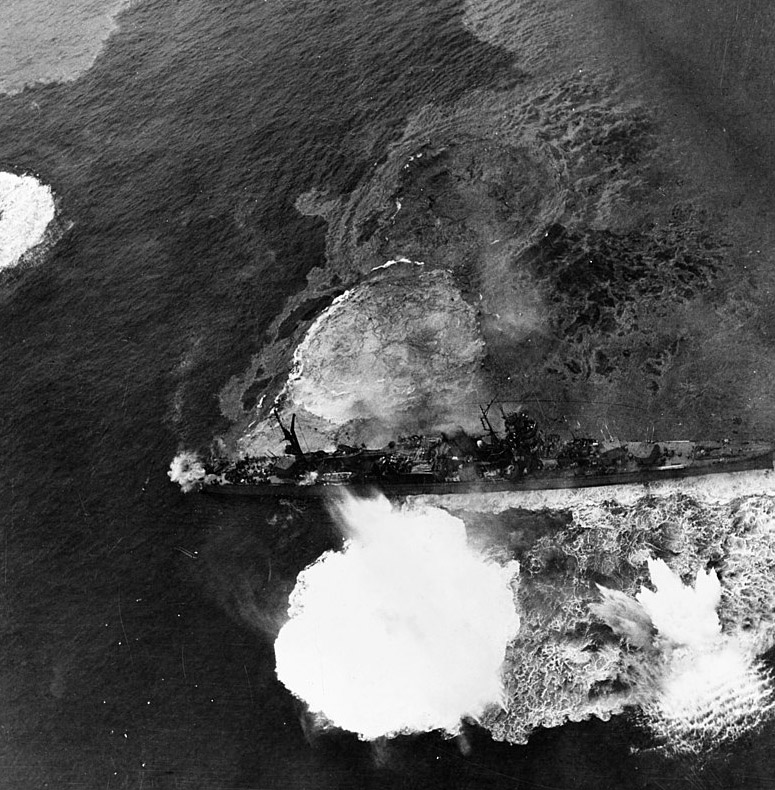
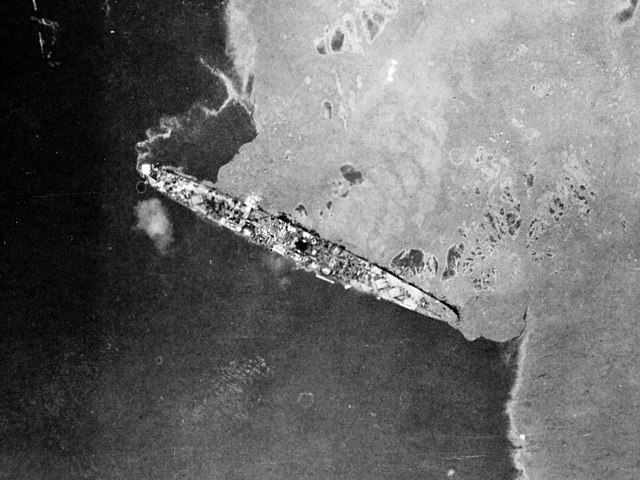
On 16 November 1944 she saw her unit, DesRon 10, deactivated and instead she became flagship, Rear Admiral Keizō Komura, for the reconstituted DesRon 2 (Isokaze, Hamakaze, Yukikaze, Kasumi, Hatsushimo, Asashimo, Fuyutsuki and Suzutsuki). She was refitted in Japan, Sasebo on 24 November and stayed there until March 1945. On 6 April 1945 she was assigned ont eone-way ticket “Operation Ten-Go”, on Okinawa, screening Yamato. At 12:20, 7 April, the force was attacked by waves of nealy TF 38 400 aircraft and at 12:46 (1st wave), she was “pincered” by Avengers and received a torpedo hit directly in the engine room. Heavily flooeded, she was soon dead in the water. Dead in the water, she became from there éterget practice” for the next waves, receiving at least six more torpedo hits, 12 bombs hits, and IJN Isokaze closed to helpe her, but was soon also badly damage and would sunk later. Other destroyers just scattered, most destroyed. She eventually capsized from her starboard side at 14:05 with 445 crewmen on board, but both RADM Komura and Captain Tameichi Hara survived, rescued later by Hatsushimo and Yukikaze. She was stricken on 20 June 1945.
 IJN Sakawa
IJN Sakawa

IJN Sakawa (after the Sakawa River) was built from November 1942 at Sasebo Naval Arsenal, but construction received low priority and she was only completed in early 1944, completed on 30 November and assigned to the Combined Fleet. On 15 January 1945 after some redumentary training she became flagship, DesRon 11, training with newly built destroyers in the Inland Sea and testing a new anti-radar submarine coating. On 1 April, she was to take part in Operation Ten-Go, on Okinawa, screening the battleship Yamato in another column with her sister Yahagi, the lack of fuel had the mission aborted for her.
Instead she stayed home for more training, until on 26 May 1945 one of her propellers struck a rock in the Kanmon Straits, but damage was light. She was repaired in the Maizuru Naval District from 19 July, but attacked by USS Yorktown air group on the 25th, and was unscaved. When Japan surrendered on 2 September she was in Maizuru inactive always due to the lack of fuel. She was later captured by occupation troops.
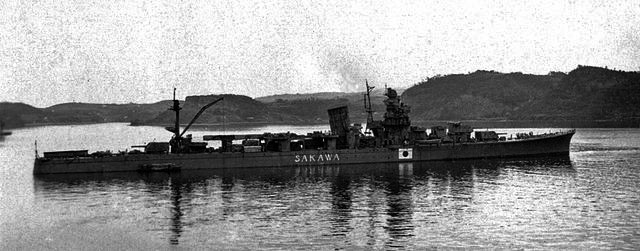
Sakawa in Sasebo, 15 October 1945
As one of the rare surviving IJN cruisers, she was demilitarized, guns removed as well as torpedoes, ammunition and AA. On 5 October, she was formally stricken, and sent to help repatriate 1,339 IJN troops between Sonsorol, Fanna, Merir and Hatohobei (southern Palau). She made other such trips until the end of February 1946, going to New Guinea, Korea and others, places she could have fought but now she toured thanks to US fuel, with her original crew.

Sakawa awaiting atomic bomb testing, 1946
On 25 February 1946, she was in Yokosuka, formally handed over to USN was war prize. The latter had no use for her except a test, to know how a fleet would fare if targeted by an atomic bomb. She was sent to Bikini for her first atomic experiments. But at that stage, the capture crew reported her awful state, with all equipments broken, leaking, and infested with rats. She departed Yokosuka with Nagato for Eniwetok manned by 165 US sailor on 18 March, and still 11 of her former officers to assist. After 10 days however, as she was some 300 nautical miles from Eniwetok, her machinery broke down. Nagato tried to tow her but this caused a boiler failure while fuel was exhausted. Both were latter resupplied by the oil tanker SS Nickajack Trail, but the latter ran aground on a reef and sank. They were eventually towed on 30 March to Eniwetok.
There she was inspected again and it appeared they were so angray about her state that they were caught sabotaging her, ruining the fuel system and pouring sand into the oil and water pumps. They also smashed gauges, tachometers, and even cut out the high-pressure steam lines. The crew was dismissed and after four days of repairs and five sailors condemned to jail sentences she eventually made her final votahe to Bikini Atoll in May.
She took part in Operation Crossroads, prepared with meany measurements devices, evanuated, and surviving the first blast and air burst called ‘Test Able’ on 1 July. She had cages onboard containing various animals for radiation effects and 450 meters (490 yd), starboard to ground zero. She was set afire, her superstructure was mushed by the blast, and her leaking worsened. She developed a slight list to port but it progressively filled the ship overnight until she settled by the stern. The tug boat USS Achomawi tried to tow her out, and she started to sink by the stern, so the tug had to cut the tow cable. Sakawa sank under 200 feet (61 m) of water in the atoll. She was completely destroyed by the underwater “Test Baker” about 500 feet (150 m) from her, flatteing her forward superstructure and making more damage to her wreck, sitting upright to this day on the sandy bottom, her hull highly irradiated.


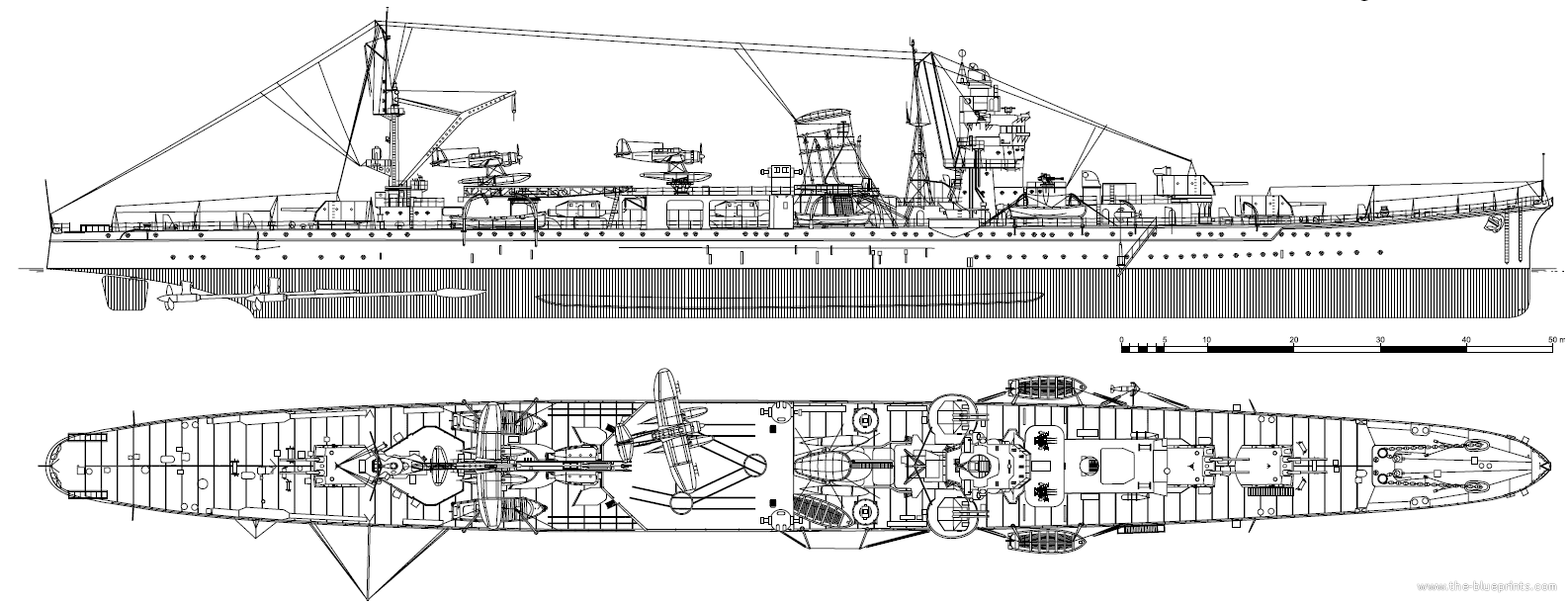


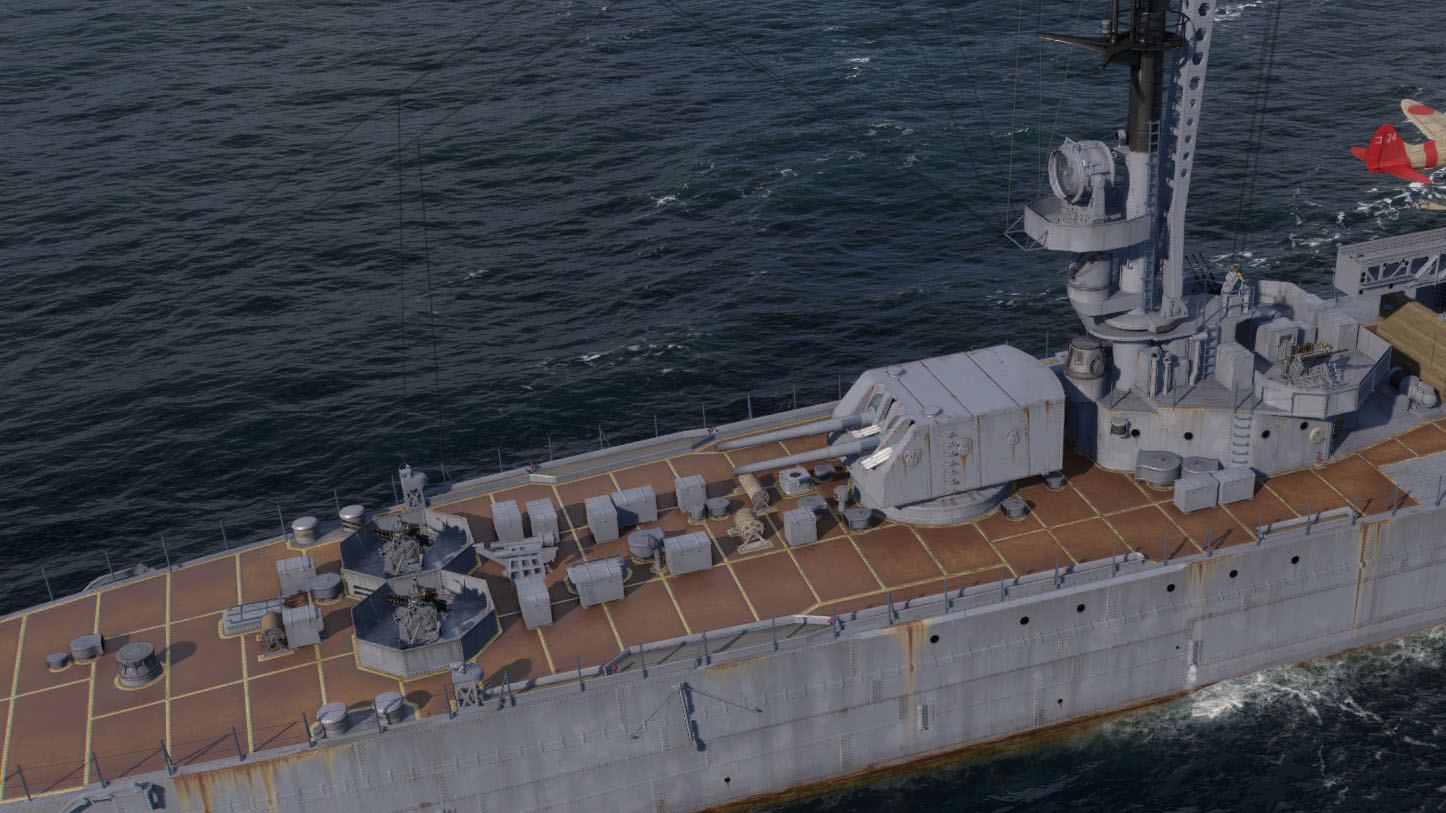
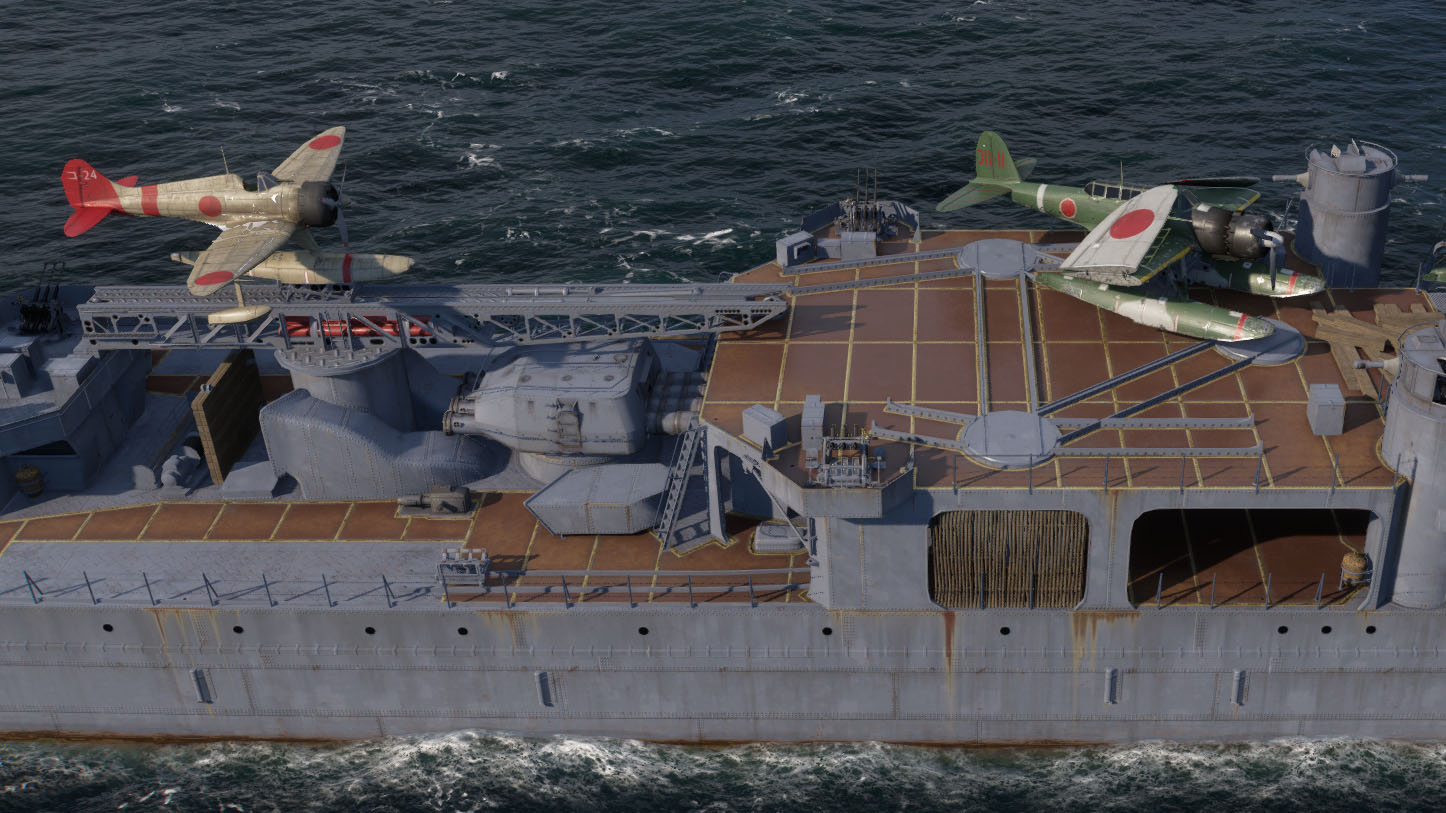
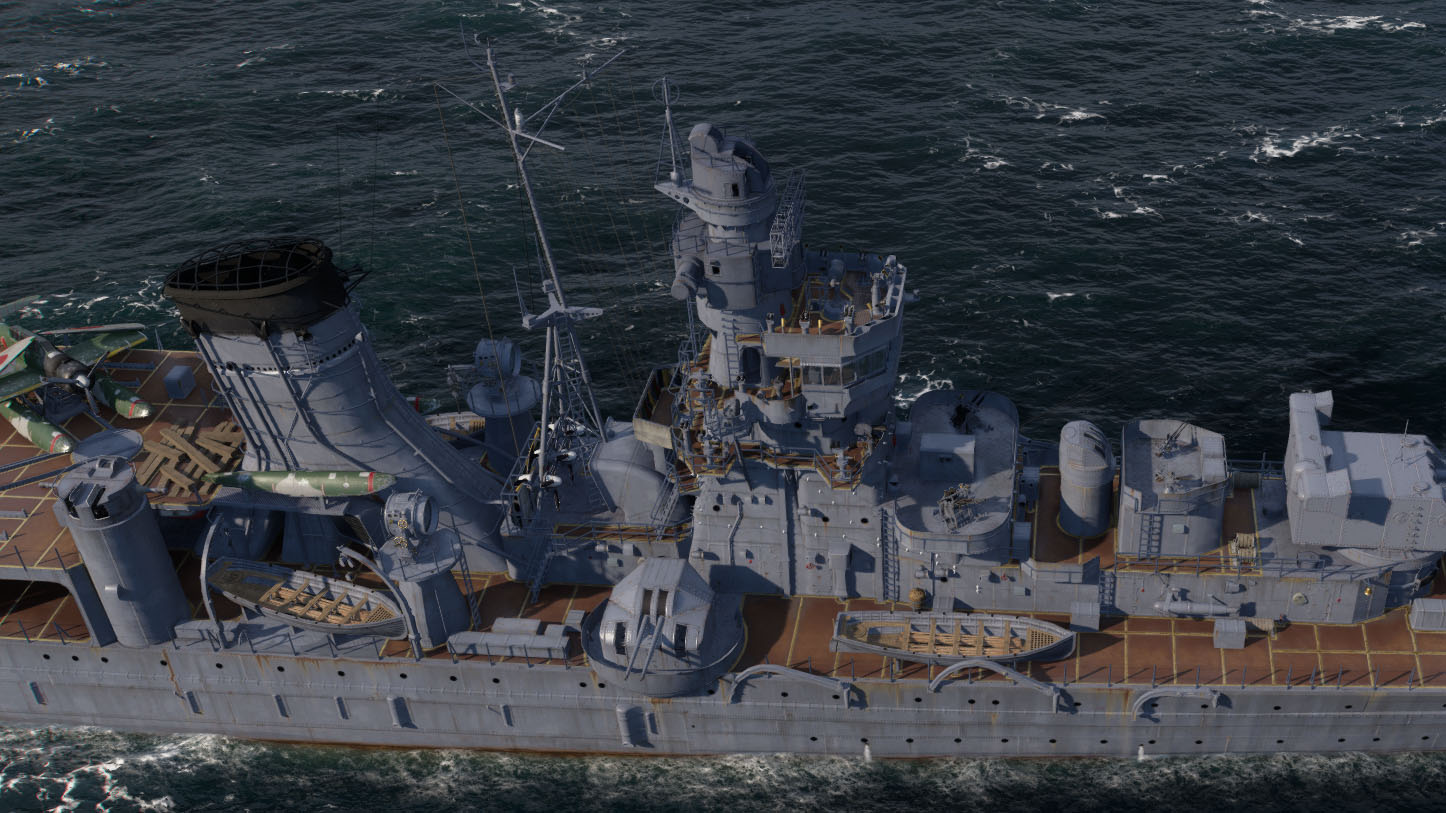
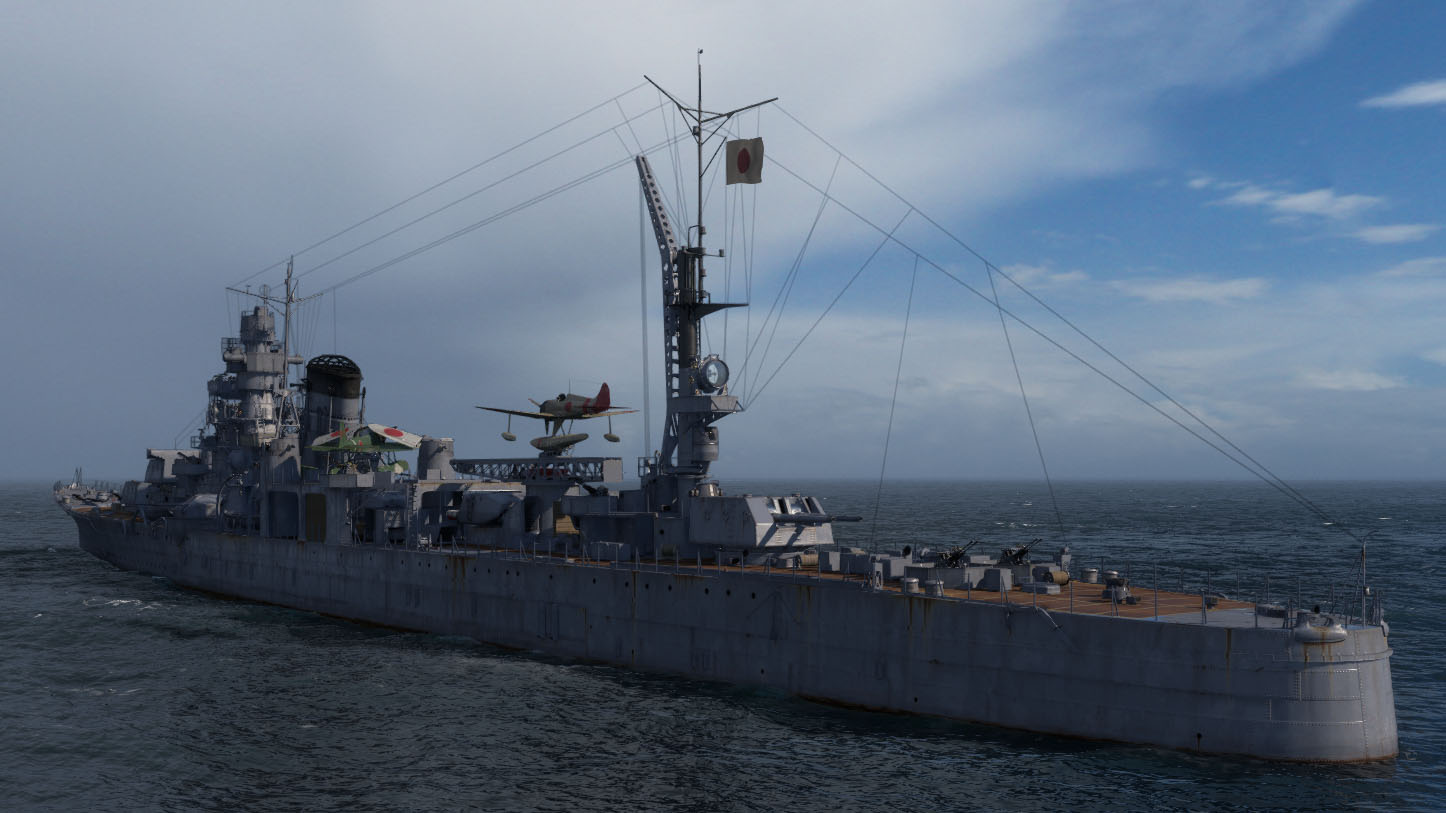
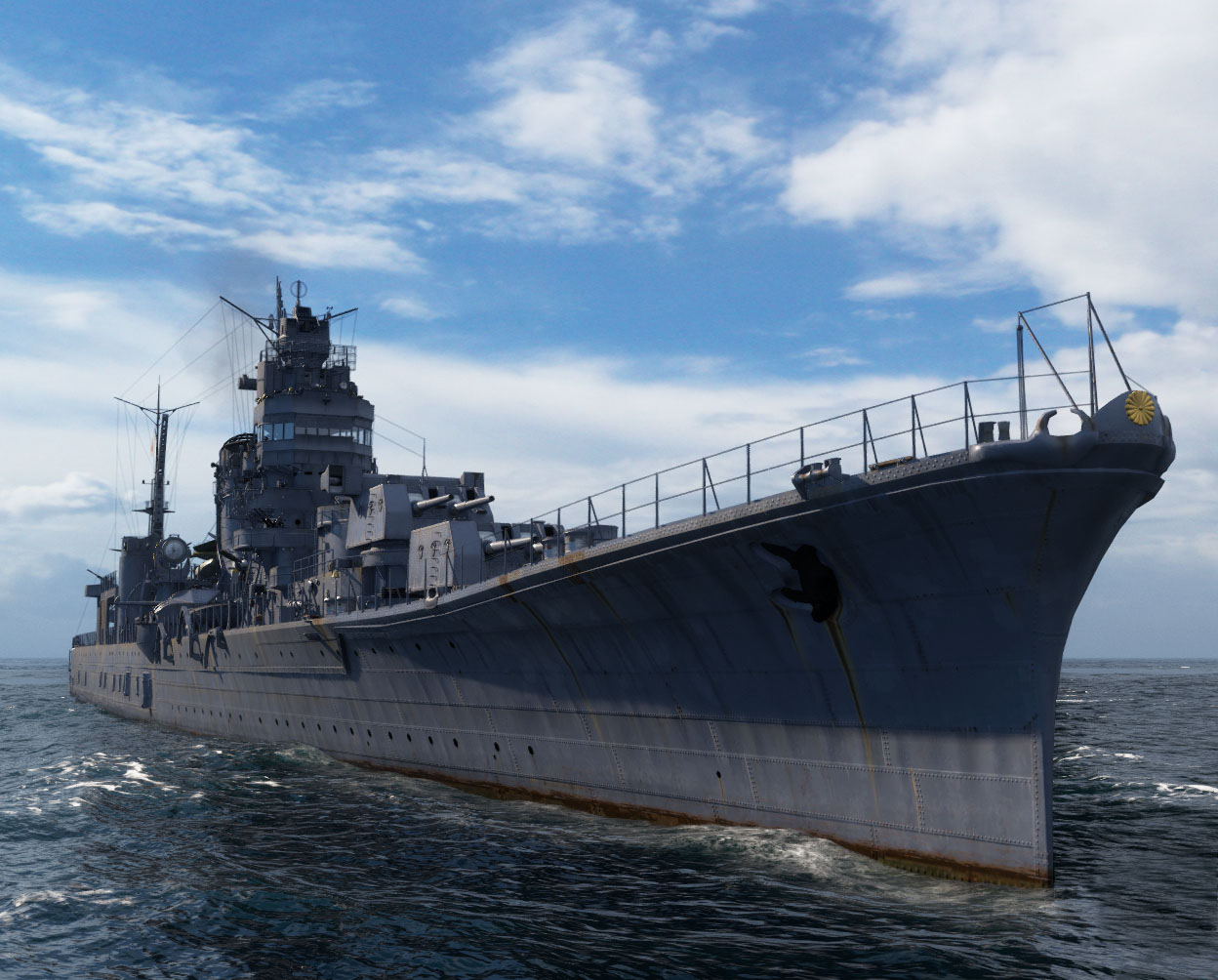

 Latest Facebook Entry -
Latest Facebook Entry -  X(Tweeter) Naval Encyclopedia's deck archive
X(Tweeter) Naval Encyclopedia's deck archive Instagram (@navalencyc)
Instagram (@navalencyc)





 French Navy
French Navy Royal Navy
Royal Navy Russian Navy
Russian Navy Armada Espanola
Armada Espanola Austrian Navy
Austrian Navy K.u.K. Kriegsmarine
K.u.K. Kriegsmarine Dansk Marine
Dansk Marine Nautiko Hellenon
Nautiko Hellenon Koninklije Marine 1870
Koninklije Marine 1870 Marinha do Brasil
Marinha do Brasil Osmanlı Donanması
Osmanlı Donanması Marina Do Peru
Marina Do Peru Marinha do Portugal
Marinha do Portugal Regia Marina 1870
Regia Marina 1870 Nihhon Kaigun 1870
Nihhon Kaigun 1870 Preußische Marine 1870
Preußische Marine 1870 Russkiy Flot 1870
Russkiy Flot 1870 Svenska marinen
Svenska marinen Søværnet
Søværnet Union Navy
Union Navy Confederate Navy
Confederate Navy Armada de Argentina
Armada de Argentina Imperial Chinese Navy
Imperial Chinese Navy Marinha do Portugal
Marinha do Portugal Mexico
Mexico Kaiserliche Marine
Kaiserliche Marine 1898 US Navy
1898 US Navy Sovietskiy Flot
Sovietskiy Flot Royal Canadian Navy
Royal Canadian Navy Royal Australian Navy
Royal Australian Navy RNZN Fleet
RNZN Fleet Chinese Navy 1937
Chinese Navy 1937 Kriegsmarine
Kriegsmarine Chilean Navy
Chilean Navy Danish Navy
Danish Navy Finnish Navy
Finnish Navy Hellenic Navy
Hellenic Navy Polish Navy
Polish Navy Romanian Navy
Romanian Navy Turkish Navy
Turkish Navy Royal Yugoslav Navy
Royal Yugoslav Navy Royal Thai Navy
Royal Thai Navy Minor Navies
Minor Navies Albania
Albania Austria
Austria Belgium
Belgium Columbia
Columbia Costa Rica
Costa Rica Cuba
Cuba Czechoslovakia
Czechoslovakia Dominican Republic
Dominican Republic Haiti
Haiti Hungary
Hungary Honduras
Honduras Estonia
Estonia Iceland
Iceland Eire
Eire Equador
Equador Iran
Iran Iraq
Iraq Latvia
Latvia Liberia
Liberia Lithuania
Lithuania Mandchukuo
Mandchukuo Morocco
Morocco Nicaragua
Nicaragua Persia
Persia San Salvador
San Salvador Sarawak
Sarawak Uruguay
Uruguay Venezuela
Venezuela Zanzibar
Zanzibar Warsaw Pact Navies
Warsaw Pact Navies Bulgaria
Bulgaria Hungary
Hungary

 Bundesmarine
Bundesmarine Dutch Navy
Dutch Navy Hellenic Navy
Hellenic Navy Marina Militare
Marina Militare Yugoslav Navy
Yugoslav Navy Chinese Navy
Chinese Navy Indian Navy
Indian Navy Indonesian Navy
Indonesian Navy JMSDF
JMSDF North Korean Navy
North Korean Navy Pakistani Navy
Pakistani Navy Philippines Navy
Philippines Navy ROKN
ROKN Rep. of Singapore Navy
Rep. of Singapore Navy Taiwanese Navy
Taiwanese Navy IDF Navy
IDF Navy Saudi Navy
Saudi Navy Royal New Zealand Navy
Royal New Zealand Navy Egyptian Navy
Egyptian Navy South African Navy
South African Navy






























 Ukrainian Navy
Ukrainian Navy dbodesign
dbodesign